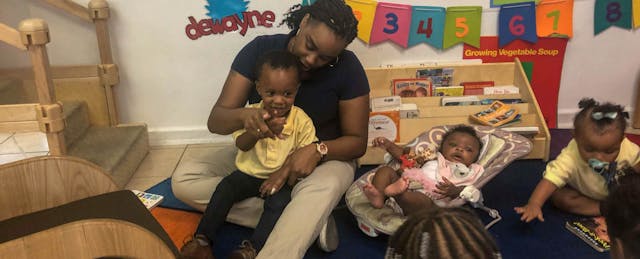NEW ORLEANS —A little boy with a plastic dinosaur toddles over to his teacher at Clara's Little Lambs Preschool Academy, in the Algiers neighborhood on the west bank of the Mississippi. “Oooooh! That's a scary dinosaur,” gasps the teacher Tracy McChester. Sitting on the mat, surrounded by a half-dozen toddlers and a baby, she asks the little boy what sound a dinosaur makes: “Roar!” he yells in delight. “Now what color is the dinosaur?” she asks. The boy answers again: “Roar!”

At first glance, it is just a cute interaction between an engaged teacher and an energetic toddler. But in Louisiana, that interaction holds a lot of meaning.
Every publicly funded early childhood center in the state gets a quality rating score of one to five stars. And that score is based entirely on classroom observations of how teachers interact with their students: how they talk to them, whether they ask engaging questions to encourage language development and critical thinking, whether they notice if a student is sad or acting out. The way that McChester encouraged a back-and-forth conversation with the little boy, and how she spoke in a warm, caring tone, was a textbook example of what observers look for.
It's a relatively simple system, but that simplicity, researchers say, is exactly why it works.
“Everything is really focused on child-teacher interactions,” says Daphna Bassok, a professor and education policy researcher from the University of Virginia who has been closely studying Louisiana's quality rating system. “It's been striking to see how much they've been able to change the culture over a relatively short amount of time.”

While teachers were skeptical of the system at first, many now say that it's transformed their teaching practice by allowing them to focus solely on what matters most: how they interact with the children in their care.
Simplifying a Complex System
Most states that evaluate child care and pre-K centers calculate a star rating based on a complex constellation of metrics—everything from teacher-student ratios to whether the books in the library are stacked at eye level. Not only are these quality rating systems hard for educators to understand, the research is mixed on whether the highest-rated centers actually have a positive effect on child development.
“The number of stars that they generate are typically not associated with children's learning,” explains Robert Pianta, dean of the Curry School of Education at the University of Virginia, and one of Bassok’s colleagues.
Louisiana is unique in basing its quality rating scores solely on classroom observations. The state decided to do a major overhaul of its early childhood education system in 2012, with the passage of the Early Childhood Education Act. First, it unified the entire early childhood field—preschool, Head Start and child care—under the control of the state's department of education. Second, it increased professional education requirements: by 2019, all lead teachers had to have at least an Early Childhood Ancillary Certificate, a credential that requires 120 hours of coursework at a state-approved program plus 480 hours of practical experience.
Finally, the reform revamped the quality rating system to focus on measures that research has shown are tied to student learning. Observations are done using a tool called the Classroom Assessment Scoring System (CLASS), which Pianta helped create in 2008. It's a tool that's been studied for decades in thousands of classrooms, and research has shown that it's linked to student gains in math, vocabulary and social skills.
Every classroom using CLASS gets observed at least twice a year; for auditing purposes, half are chosen at random to get observed three times a year. This wide scope makes Louisiana unique; while 22 states use CLASS as part of their school quality rating systems, it’s usually voluntary or only a subset of classrooms.
“It is very time consuming and the scope of this is massive,” says Bassok.
Importantly, everything that teachers are scored on with CLASS is directly within their control—unlike, say, the student-teacher ratio.
“They wanted to make it simpler. They wanted to make it fully transparent so everyone would know what these scores meant,” says Pianta.
Teachers were uncomfortable with the changes at first. “Everyone hated it when it originally started,” admits Sonjia Joseph, the director of Clara's Little Lambs. What if observers come when a teacher is having a bad day? How could you judge a school based on two visits a year to each classroom? (Pianta notes that researchers tested whether CLASS observations were more accurate if they were done every two weeks instead of twice a year, but it made no difference.)
These concerns matter, because center ratings in Louisiana are high stakes: parents see them online and the center can earn tens of thousands of dollars in tax credits for high scores. The tax credit rewards are based on the quality rating and the number of children from families receiving child care assistance or foster children served. A five-star center will earn $1,500 in tax credits for every Child Care Assistance Program or foster care child enrolled, while a three-star center earns $1,000. Schools that are rated zero stars for two years out of three may be shut down (although that's rare; only five centers out of 1590 in the entire state received zero stars in 2017-18.)

Despite Joseph’s initial skepticism, her employees quickly got used to the observation system. Last year the center earned three stars, which is considered “proficient,” and got $30,000 in tax credits, Joseph says. She plans to use the money to buy a new air conditioner—a worthy investment, considering that New Orleans was still experiencing nearly 100-degree weather in October.
She also uses the CLASS tool to motivate teachers. A teacher’s score has no impact on compensation, but Joseph motivates her team by awarding her highest-scoring teachers with a free trip to an early childhood education conference.
And, she discovered, the observations are “absolutely helpful in terms of training.” Teachers get detailed feedback on how to improve within 10 days of the observation. The teachers or center directors often use the feedback to guide their selection of professional development programming.
Tyamber Moore, for example, teaches with McChester at Clara's Little Lambs and had her observation in September. Within a week, she received three detailed pages of notes. She scored highest in the “Positive Environment” category: “The teachers and children enjoyed warm, supportive relationships with one another,” the observer wrote, with “frequent episodes of the teachers and children smiling and laughing.”
For areas to improve, the observer suggested that Moore work more on encouraging meaningful, back-and-forth conversations between herself and the kids. Sometimes she asked a question, but then answered it herself.

Moore takes this feedback to heart. She'll look up YouTube videos and Udemy online courses to learn more about the areas she needs to work on. And she'll turn to her fellow educators.
“Maybe one teacher is lacking; this is her strength or this is her weakness. We help each other out,” she says.
The state prioritizes supporting struggling centers. Any school that scores two stars or below must develop an improvement plan, with guidance from the state department of education. Ninety percent of schools that participated in the planning process last year improved; almost half of them improved their CLASS scores by a whole point.
Building Buy-in
Not every teacher buys into the observation system.
“It's a lot of pressure on the teachers,” says Shayanna Payton, another teacher at Clara's Little Lambs. She thinks that every observer grades differently, and that the grades don't always reflect what really happened in the classroom.
However, Payton's views are in the minority. According to a teacher survey that Bassok administered, around 70 percent of educators think the system is a good measure of quality, and over 60 percent say they have personally improved because of it.
Bridget Hamre, a professor at the University of Virginia and co-creator of CLASS, credits Louisiana’s success in creating this buy-in to the fact that it gives local leaders and teachers control. Local administrators conduct most observations (third-party audits ensure bias doesn’t affect the scores). Since everyone uses a “common language around what good teaching looks like,” there’s a strong sense of unity between preschool, child care and Head Start. Hamre says one public school superintendent paid for professional development training for a local private preschool and Head Start, because he knew those kids would one day be his kindergarteners.
“That kind of thing you just don’t hear about,” said Hamre. “That sort of pulling together across sectors at a local level—and making people feel we really are a system, we're all taking care of our kids—has been powerful.”
Overall, the system seems to be improving teacher quality with 77 percent of sites rated “Proficient” or higher in 2017-18, compared to 68.5 percent in 2015-16. CLASS scores improved across the board, in preschools, Head Start and child care programs, which suggests that teachers were improving their practice in response to the feedback and training they received. In contrast, with the old system, called Quality Start, most centers stagnated: 76 percent scored only 1 out of 5 stars.
The fact that this data even exists in Louisiana makes researchers excited.
“We talk all over the country about wanting to improve early childhood classrooms, but there's hardly ever any data that would actually tell us: are classrooms actually getting better?” says Bassok.
After a busy morning of stacking blocks and trying on costumes, Moore and McChester sit their kids down for lunch. Even then, there are opportunities for learning: a sign near the table shows a long list of mealtime conversation starters. “Where do you think this food came from?” “Tell me about a meal you had with your family." "What challenges did you conquer today?” “What amazing things did you discover?”
Reflecting on the challenges she's conquered, Moore says she's glad to work in a place where she can always learn more and improve.
“It's a great adventure,” she adds. “It's a task, but it's worth it. It's very much worth it.”


